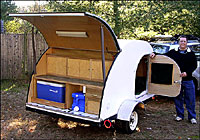For those following for the first time here's a bit of a background:
We've been working on our build and are posting our progress on YouTube - Just for fun (not monetized).
Our Goal - to build a lightweight low-voc mold resistant camper that's affordable.
With my health issues hotels and regular campers are not an option - but just like everything else we've done - We'll build it ourselves.
So we started the journey to build our little non-toxic camping pod that can slide on to a utility trailer, have a place to wash up (very important with health issues) and be light enough to be towed by our 4 cylinder CX5. Everything inside will need to run off solar as well.
For this trailer build we are challenged with finding materials that are lightweight, low voc and mold resistant here locally (Newfoundland).
We initially wanted to purchase an aluminum trailer but budget didn't permit it - so we purchased a Stirling 5x10 galvanized trailer.
The design we came up with will be similar to a truck camper in that the little camper pod will be able to be removed from the trailer - so we can upgrade in the future if needed.
We have to find low wattage appliances and have been researching unique solar solutions for appliances, hot water, toilets and the like.
After much research and with limitations in material options living on an island, we decided that we would go with an exterior shell of ACM that can be bought locally at EM Plastics, ACM is Aluminum composite material with a polyethylene core layer and aluminum heat pressed on both or one sides, this product comes with a protective coating suitable for outdoor use, is flexible but strong enough that we can omit using plywood. We initially looked at fylon or coil stock aluminum but these option require a plywood base and we wanted to get away from using plywood if possible. They also require glues and the aluminum coil stock was unfinished so would require paint or a coating.
For the insulation we opted for SilveRboard is a rigid insulation board made from Expanded Polystyrene (EPS) covered with a layer of polypropylene reflective lamination on both sides - Foil backed EPS t's not prone to mold and will not hold moisture like batt insulation.
I'm leaning toward using the fiberglass reinforced polyester for the interior walls and ceilings but haven't tested it yet to see if I'm compatible, if not we will go with aluminum coilstock.
For the cabinets we will use whatever leftover ACM we have unless we can find affordable Metal, PP or PE cabinetry.
The frame was constructed from standard spruce lumber.
For adhesives, sealants & caulks, I'm going with what I know works for me that is readily available, that's PL Premium Fast Grab which works as a great adhesive to almost any surface and meets LEED standards due to its low-VOC, toluene-free formula. In the past I've used Dap 100% pure silicone caulking without issue once it's fully cured but there are other caulking on the market now that may be better - so I'll have to try them out.
So that's the idea, things may evolve as we go but stay tuned we'll show you how it's coming along as we progress.

If you want to catch up, here's the playlist: https://www.youtube.com/watch?v=I7hE0CR4skI&list=PL3xH6AKVUIyhKBBMhYYJ7pHxtnjzy8D0V
We are now on day 37:
Day 37: VHB FAIL, Replacing Window Screws & Cabinet Rebuild - Building a Full Height Teardrop
What a good hubby! He already built the cabinet - then re-built it - Then I had a better idea so he had to rebuild it again...


